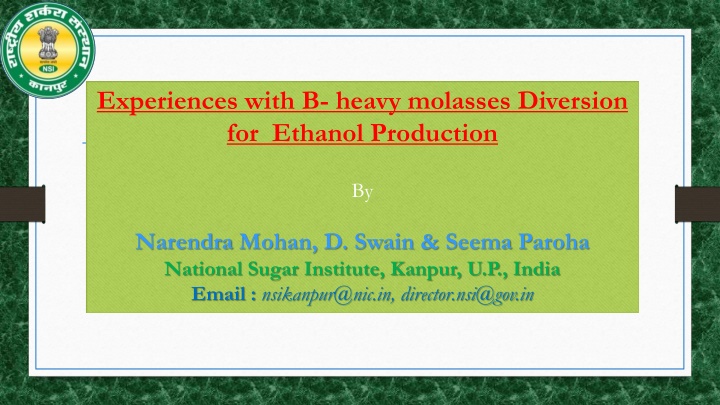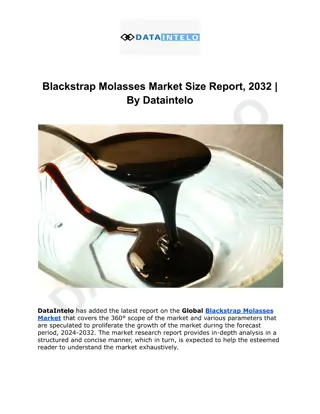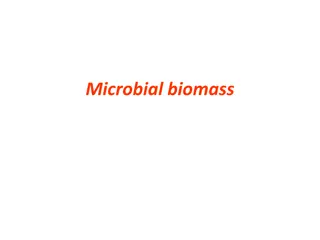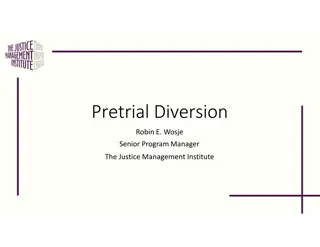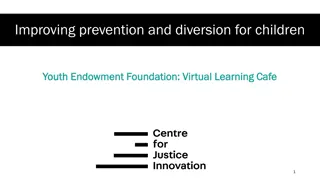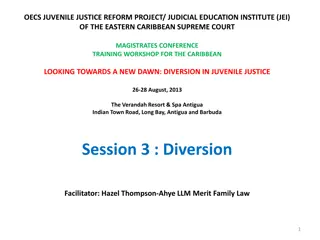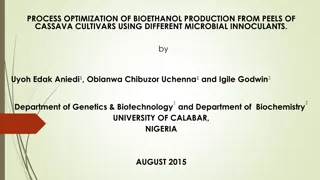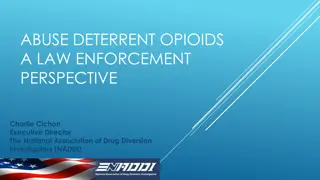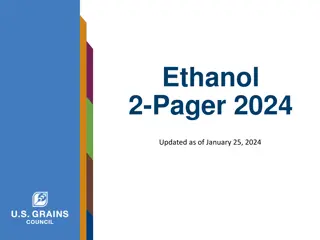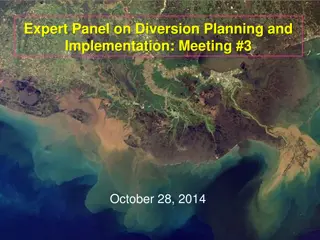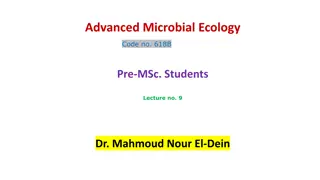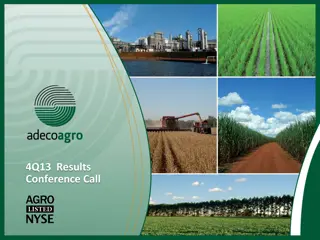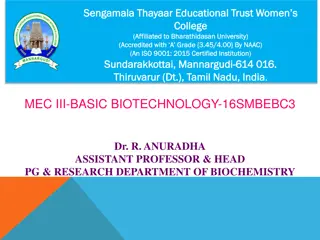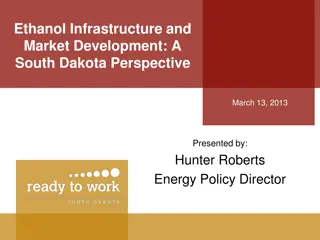Enhancing Ethanol Production Through B-Heavy Molasses Diversion
The Indian government has implemented the Ethanol Blending Petrol Programme to promote alternative fuels and reduce import dependence. Measures such as diverting B-heavy molasses for ethanol production aim to support the agriculture sector and manage surplus sugar production. This initiative involves differential pricing and aims to increase ethanol availability while reducing sugar content. The efforts have significantly boosted ethanol supply over the years, with a focus on energy security and renewable energy sources.
Download Presentation

Please find below an Image/Link to download the presentation.
The content on the website is provided AS IS for your information and personal use only. It may not be sold, licensed, or shared on other websites without obtaining consent from the author.If you encounter any issues during the download, it is possible that the publisher has removed the file from their server.
You are allowed to download the files provided on this website for personal or commercial use, subject to the condition that they are used lawfully. All files are the property of their respective owners.
The content on the website is provided AS IS for your information and personal use only. It may not be sold, licensed, or shared on other websites without obtaining consent from the author.
E N D
Presentation Transcript
Experiences with B- heavy molasses Diversion for Ethanol Production By Narendra Mohan, D. Swain & Seema Paroha National Sugar Institute, Kanpur, U.P., India Email : nsikanpur@nic.in, director.nsi@gov.in
Background Ethanol Blending Petrol Programme (EBP) was launched by the Government in 2003 on pilot basis in some states. Subsequently extended to the Notified 21 States and 4 Union-Territories to promote the use of alternative and environment friendly fuels. This intervention also seeks to reduce import dependence for energy requirements and give boost to agriculture sector.
Background Continued Government has notified the National Biofuel Policy according to which 10% blending of ethanol into petrol has been targeted through various feed stocks other than the conventional route of Final Molasses. The government initiatives and policies have significantly improved the supply of ethanol during the past four years. The ethanol procured by Public Sector OMCs has increased from 38 crore litre in ethanol supply year 2013-14 to little above 160 crore litre in 2017-18 and this year it is expected to achieve blending to the extent of 8%.
Background Continued Consistent surplus of sugar production is depressing sugar price. Consequently, sugarcane farmer's dues have increased due to lower capability of sugar industry to pay the farmers. With a view to limit sugar production in the Country, Government has taken multiple steps including allowing diversion of B heavy molasses / sugarcane juice for production of ethanol.
Background Continued For many reasons including energy security, having green & renewable energy and balancing demand-supply scenario of sugar, ethanol production is being favored. To enhance the ethanol production, the Government of India has announced a differential pricing policy for ethanol produced from conventional route, through diversion of B Heavy molasses and also through partial or 100% diversion of sugarcane juice. It is worth noting that as compared to ethanol derived from C- heavy molasses route, diversion of B heavy molasses reduces the sugar by 15-20 % and increases ethanol availability by about 90-100%. On the other hand, diversion of sugarcane juice reduces sugar by 100% and increases ethanol availability by about 580-600%.
Background Continued The ex-mill price of ethanol derived out of B heavy molasses / partial sugarcane juice has been fixed as Rs.52.43 per litre. The ex-mill price of ethanol derived from 100% sugarcane juice has been fixed as Rs.59.13 per litre for those mills who will divert 100% sugarcane juice for production of ethanol thereby not producing any sugar. Additionally, GST and transportation charges will also be payable. OMCs have been advised to fix realistic transportation charges so that long distance transportation of ethanol is not disincentivised. OMCs are advised to prioritize ethanol in the following order 1) 100 % sugarcane juice, 2) B heavy molasses / partial sugarcane juice, 3) C heavy molasses and 4) Damaged Food grains/other sources.
Expected Impacts The decision will serve multiple purposes of reducing excess sugar in the country, increasing liquidity with the sugar mills for settling cane farmer's dues and making higher ethanol available for Ethanol Blended Petrol (EBP) Programme. All distilleries will be able to take benefit of the scheme and large number of them are expected to supply ethanol for the EBP programme. Remunerative price to ethanol suppliers will help in reduction of cane farmer's arrears, in the process contributing to minimizing difficulty of sugarcane farmers. Ethanol availability for EBP Programme is expected to increase significantly due to higher price being offered for procurement of ethanol from B heavy molasses / partial sugarcane juice and 100% sugarcane juice for first time. Increased ethanol blending in petrol has many benefits including reduction in import dependency, support to agricultural sector, more environmental friendly fuel, lesser pollution and additional income to farmers.
ECONOMICS OF ETHANOL PRODUCTION THROUGH DIFFERENT ROUTES Based on the latest price of ethanol as Rs. 43.46 from Final Molasses Rs. 52.43 from B-Heavy Molasses Rs. 59.13 from Direct Cane Juice Economy of Ethanol Production has been worked out
Theoretical Economics of B- Heavy Molasses Diversion Basis BASIS Average recovery of sugar production Final Molasses % Cane B Heavy Molasses % Cane Percentage Reduction of Sugar in case of B Heavy diversion : 15.73 Yield of Ethanol from Final Molasses in litre/Ton Yield of Ethanol from B Heavy Molasses in litre/Ton : 10.80 : 4.5 : 6.7 : 235 : 310
Basis Continued Specific Gravity of Alcohol Un-Fermentable Sugar % in Final Molasses Fermentation Efficiency % Distillation Efficiency % Cane Price :Rs. 297/Qtl : 0.789 : 5 : 91 : 98 In order to fix the percentage of B Heavy and the recovery after B Heavy diversion, it is assumed that whatever additional ethanol that has been produced, it is at the expense of the recovery.
B Heavy Diversion Route Contd. Particulars Cane Crushed Recovery Sugar Price Gross Revenue from Sugar Conversion cost Net Revenue from Sugar Molasses Ethanol Production Rate Ethanol Production Units Ton % Cane Rs. / kg Rs. Rs. / kg Rs. % Cane Litre/Ton Litre F M BH 1 1 10.8 32 3456 9.10 32 15.7 2912.4 5 5 -54 4.5 235 10.58 -512.69 6.7 310 20.77 49 96
B Heavy Diversion Route Contd. Ethanol Price Rs. / Litre 43.46 52.43 Gross Revenue from Ethanol Rs. 459.59 1088.97 Conversion cost Net Revenue from Ethanol Additional Power Export Power Price Gross Revenue from Power Conversion cost Net Revenue from Power Press Mud Production Price of Press Mud Net Revenue from PM Total Net Revenue Difference Rs. / Litre Rs. kWh Rs/kWh Rs Rs/kWh Rs. Ton Rs/Ton Rs Rs. Rs. 12 12 332.69 90.00 5.00 450.00 1.50 315.00 0.035 250.00 8.75 602.44 839.73 92.00 5.00 460.00 1.50 322.00 0.035 250.00 8.75 657.79 55.35
B Heavy Diversion Route Contd. Final Molasses Vs B-Heavy Total Revenue Generated in Rs. 5,700 5,562 5,600 5,454 5,500 5,346 5,400 5,238 5,438 5,130 5,300 5,347 5,022 5,200 5,1655,256 5,100 4,914 5,000 5,074 4,900 4,801 4,983 4,892 4,800 4,806 4,710 4,700 4,698 Final Molasses B Heavy 4,619 4,600 4,590 4,528 4,500 4,482 4,450 4,400 4,374 4,300 Sugar Price in Rs. 4,200 32 33 34 35 36 37 38 39 40 41 42 43
B Heavy Diversion Route Contd. 1.6 100.00 1.8 75.68 1.6 1.5 1.5 1.6 45.88 1.5 Difference in Rs /Ton Cane 40.78 1.4 50.00 Ethanol Price/Sugar Price 1.4 28.88 1.3 1.3 1.4 1.3 12.98 11.88 1.2 1.2 0.00 1.2 -5.12 36 32 33 34 35 37 38 39 40 41 42 43 1.0 -21.02-38.02-55.02-72.03-89.03-106.03 -22.13-39.13-56.13-73.13-90.13-107.13 -4.02 -50.00 0.8 -100.00 0.6 0.4 -123.03 -124.13 -150.00 -140.03 0.2 -157.03 -200.00 0.0 Sugar Price per kg Total Revenue Net Earnings Ethanol Price/Sugar Price The net profit of the plant as a whole remains positive till the price of sugar reaches between Rs. 33 and 34 per kg.
Basis of comparison Particulars Unit Value Dhampur Ninainadevi Actual Average Sugar Recovery % Cane 10.63 12.24 Calculated Sugar Recovery % Cane 12.14 13.19 Loss of Recovery % Cane 1.51 0.95 B Heavy % on Cane % Cane 5.81 4.23 Alcohol Yield from B- Heavy Liter/Ton 310 317
Case Study: Economics of B-Hy Diversion (DHAMPUR) MARGIN RATIO Profit per ton of canein Rs. 39.15 22.56 7.46 1.54 34 1.64 32 1.59 33 1.50 1.46 36 1.42 37 1.38 38 1.34 39 1.31 40 1.28 41 -7.64 35 -22.74 -37.84 -52.94 -68.04 -83.14 -98.24 Sugar Price per kg in Rs.
Case Study: Economics of B-Hy Diversion (NINAIDEVI) Margin in case of B-Heavy NINAIDEVI Profit per ton of canein Rs. 41.15 31.54 MARGIN RATIO 22.04 12.54 3.04 1.46 36 1.64 32 1.59 33 1.54 34 1.50 35 1.42 1.38 38 1.34 39 1.31 40 1.28 41 -6.46 37 -15.96 -25.46 -34.96 -44.46 Sugar Price per kg in Rs.
DHAMPUR SUGAR MILLS LTD, DIST- BIJNOR (U.P.) B-Heavy 200 204851 6600 1757250 1712167 58.91 55.02 30.96 88.47 98.13 86.81 11.87 2.37 0.15 6.32 1.52 Units Particulars C-Heavy 200 2011052.6 90450 25305000 25977000 48.11 43.8 23.8 85.9 98.2 84.9 8.47 2.79 0.16 9.19 KLPD Lts Qtls Lts Lts % % Lt/Qtl % % % % Kg/Lt kWH/Lt % % Capacity Ethanol Production Molasses Consumption Wash Distilled Wash Made Molasses TRS Fermentable Sugar Recovery Fermentation Efficiency Distillation Efficiency Overall Efficiency Alcohol in wash Steam Consumption Power Consumption Spent Wash Generation Sugar loss
SHRI DATTA SAKHAR KARKHANA LTD, A Unit of Dalmia Bharat Sugar and Industries Ltd Kolhapur ( Maharashtra ) B-Heavy 60 55767 3405.78 184.5 487527 500292 59.65 55.96 32.07 90.25 98.53 88.92 12.31 3.87 0.314 6.3 0.95 Units Particulars C-Heavy 60 48118 - 194.4 441653 447850 48.82 43.32 24.76 89.99 98.50 88.65 11.05 5.21 0.352 6.8 KLPD Litre Litre Qtls Lts Lts % % Lt/Qtl % % % % Kg/Lt kWH/Lt lts/lts % Capacity Ethanol Production RS produce Molasses Consumption Wash Distilled Wash Made Molasses TRS Fermentable Sugar Recovery Fermentation Efficiency Distillation Efficiency Overall Efficiency Alcohol in wash Steam Consumption Power Consumption Spent Wash Generation Sugar loss
Conclusion 1.Diversion of B-Hy molasses for ethanol production may be an attractive preposition at the prevailing sugar prices. 2.At the prevailing prices of ethanol produced from B-Hy molasses, even with sugar prices up to around Rs 35/-per kg. It would be advantageous to produce ethanol. 3. With B-Hy molasses, there shall be gain in capacity of the distillery, increased in distillation & fermentation efficiencies and reduction in consumption of utilities. 4. Diversion of B-Hy molasses may prove to be an effective measure in balancing the demand supply position of sugar. 5.Minimum changes are required in the sugar factory and distillery set up except for those required as per guide lines issued by the government of India
Thanks Thanks
